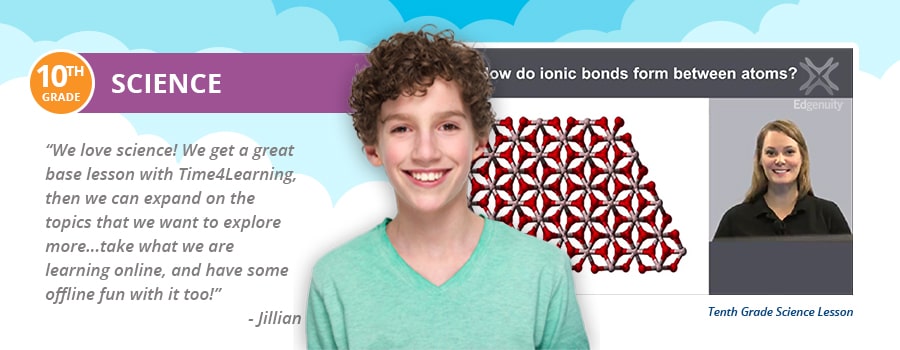10th Grade Science Curriculum
A 10th grade science curriculum should focus on more complex scientific formulas, which will prepare your child for future learning. Independent learning also becomes more important during this time, as students will be doing more laboratory experiments.
Time4Learning auto-assigns Chemistry for 10th grade science but parents can easily access subjects such as biology and physics. Learn more about what science your student should study in sophomore year and how Time4Learning can help you achieve their learning goals.
What Do You Teach in Science in Tenth Grade?
In tenth grade science, the curriculum should include the composition and properties of matter, changes and interactions of matter, organic chemistry, nuclear chemistry and more. These topics will help them meet their tenth grade objectives at year’s end.
The following are some additional topics that a tenth grade science curriculum should include:
- The historical development of the atomic theory
- Elements, compounds and mixtures
- The types of chemical bonds
- Balancing oxidation-reduction equations
- How kinetic-molecular theory explains the properties of gases
- Properties of acids and bases
- Types of radioactive decay
Although Time4Learning auto-assigns chemistry for 10th grade science, parents can also access biology and physics courses.
Tenth Grade Science Goals/Objectives
A tenth grade science curriculum should provide objectives for your child. By the end of the tenth grade your student should have a detailed understanding of states of matter, chemical reactions, the periodic table and more.
Your science objectives for tenth grade should follow along these lines:
- Accurately describe indicators of chemical change.
- Express the arrangement of electrons of atoms using electron configurations.
- Explain the concept of reaction rate.
- Explain how dimensional analysis works.
- Apply Dalton’s law of partial pressures to describe the composition of gases.
- Describe what a half-life is.
Time4Learning’s 10th Grade Science Lesson Plans
- Changes in Matter
- Lab: Physical and Chemical Changes
- Elements, Compounds, and Mixtures
- Mixtures and Solutions
- Solutions and Solubility
- Lab: Solubility
- The Structure of the Atom
- The Historical Development of Atomic Theory
- The Modern Atomic Theory
- Atomic Numbers and Electron Configurations
- The History and Arrangement of the Periodic Table
- Electrons and Periodic Table
- Periodic Trends
- Types of Chemical Bonds
- Ionic Bonding
- Nomenclature of Ionic Compounds
- Metallic Bonding
- Covalent Bonding
- Nomenclature of Covalent Bonds
- Lab: Ionic and Covalent Bonds
- Intermolecular Forces
- Evidence of Chemical Reactions
- Writing and Balancing Chemical Equations
- Types of Reactions
- Lab: Types of Reactions
- Oxidation-Reduction
- Balancing Oxidation-Reduction Equations
- Reaction Rate
- Lab: Reaction Rate
- Catalysts
- Reversible Reactions and Equilibrium
- Scientific Notation and Significant Figures
- Dimensional Analysis
- Molar Masses
- Introduction to Stoichiometry
- Stoichiometric Calculations
- Limiting Reactant and Percent Yield
- Measures of Concentration: Molarity
- Cumulative Exam
- Gases
- Liquids
- Solids and Plasmas
- Phase Changes
- Gas Laws
- Lab: Charles’s Law
- Lab: Boyle’s Law
- The Ideal Gas Law
- Energy
- Heat
- Calorimetry
- Lab: Calorimetry and Specific Heat
- Thermochemical Equations
- Enthalpy and Phase Changes
- Enthalpy of Reaction
- Lab: Enthalpy
- Enthalpy, Entropy, and Free Energy
- Properties of Acids and Bases
- Arrhenius, Bronsted-Lowry, and Lewis Acids and Bases
- pH
- Lab: Measuring pH
- Neutralizing Reactions
- Titration Reactions
- Lab: Titration
- Organic Compounds
- Properties and Uses of Saturated Hydrocarbons
- Properties and Uses of Unsaturated Hydrocarbons
- Functional Groups
- Organic Reactions
- The Nucleus
- Types of Radioactive Decay
- Balancing Nuclear Reactions
- Half-Life
- Lab: Half-Life
- Nuclear Fission and Nuclear Fusion
- Nuclear Energy
- Nuclear Radiation
- Cumulative Exam
Why Choose Time4Learning Tenth Grade Science Homeschool Curriculum
With Time4Learning, parents can customize their course choices based on their student’s skills level, interests and overall high school school plans. Parents have the option of exploring courses in biology, chemistry, and physics. Either path you choose, you’ll find that our wide-range of interactive courses, entertaining activities, and experienced teachers will help your child meet their learning objectives.
You can use Time4Learning as a full time curriculum, a summer learning curriculum, or as an afterschool skill-building tool. It’s flexibility allows parents to use it in many applications, and the additional parental tools make homeschooling much more enjoyable for both new and veteran homeschoolers.






